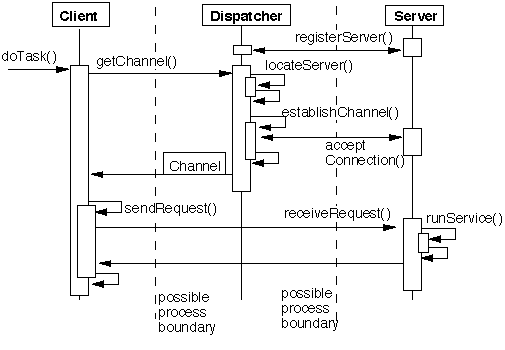 |
CS 696 Emerging Technologies: Distributed Objects |
|
|---|
Spring Semester, 1998
Some RMI Patterns
To Lecture Notes Index
© 1998, All Rights Reserved, SDSU & Roger Whitney
San Diego State University -- This page last updated 21-Apr-98
Contents of Doc 18, Some RMI Patterns
| References | slide # 1 |
| |
| Client-Dispatcher-Server | slide # 2 |
| ...Context | slide # 2 |
| ...Structure | slide # 3 |
| ...Dynamics | slide # 4 |
| ...Variants | slide # 5 |
| ...Consequences | slide # 7 |
| ...Know Uses | slide # 8 |
| |
| Proxy | slide # 9 |
| ...Structure | slide # 9 |
| ...Dynamics | slide # 10 |
| ...Reasons for Object Proxies | slide # 11 |
References
Pattern-Oriented Software: A System of Patterns, Buschman, Meunier,
Rohnert, Sommerlad, Stal, 1996, pp 323-338 (Client-Dispacther-Server),
pp 263-275 (Proxy)
Design Patterns: Elements of Reusable Object-Oriented Software, Gamma,
Helm, Johnson, Vlissides, 1995, pp 207-218
Client-Dispatcher-Server
Context
A software system integrating a client with a set of
distributed servers, with the servers running locally or
distributed over a network
Problem
How to find the servers?
A client should be able to use a service independent of
the location of the service provider (server)
The code implementing the functional core of a client
should be separate from the code use to establish a
connection with the server
Solution
Provide a dispatcher components to act as an
intermediate layer between clients and servers
Structure

Dynamics

Variants
Distributed Dispatchers
Each machine has its own dispatcher
When a client needs to connection to a server on a
remote machine:
- The client connections to its local dispatcher
- The local dispatcher connects to the remote
dispatcher
- The remote dispatcher returns the server
communication channel to the local dispatcher
- The local dispatcher returns to server
communication channel to the client
- The client now uses the communication channel to
interact with the remote server
Communication Managed by clients
The dispatcher returns the physical server location to the
client
The client manages all the communication with the
server including opening the communication channel
Variants Continued
Heterogeneous Communication
Different servers use different communication
mechanisms
- Sockets
- Pipes
When a server registers itself with the dispatcher it
specifies the communication mechanism it supports
Client-Dispatcher-Service
Clients request a service from the dispatcher
The dispatcher looks up all servers that provide that
service and opens a communication channel to one of
those servers
Consequences
Benefits
- Exchangeability of servers
- Servers can be added or modified without
modifications to the dispatcher or clients
- Location and migration transparency
- Servers can be dynamically migrated to other
machines as long as a client is not connected to the
server
- Decisions about where and which servers are part of
the system can be decided have start-up time or
later
- A new server can be activated on a different
machine when there is a network or server failure
Liabilities
- Dispatcher overhead
- Sensitivity to change in the interfaces of the
dispatcher
Know Uses
Sun's implementation of remote procedure calls (RPC)
Java's RMI
OMG Corba
Proxy
proxy n. pl prox-ies The agency for a person who acts as
a substitute for another person, authority to act for
another
Structure

The Pattern
The proxy has the same interface as the original object
Use common interface (or abstract class) for both the
proxy and original object
Proxy contains a reference to original object, so proxy
can forward requests to the original object
Dynamics

Reasons for Object Proxies
Remote Proxy
- The actual object is on a remote machine (remote
address space)
- Hide real details of accessing the object
- Used in CORBA, Java RMI

public class HelloClient {
public static void main(String args[]) {
try {
String server = getHelloHostAddress( args);
Hello proxy = (Hello) Naming.lookup( server );
String message = proxy.sayHello();
System.out.println( message );
}
catch ( Exception error)
{ error.printStackTrace(); }
}
Reasons for Object Proxies Continued
Virtual Proxy
- Creates/accesses expensive objects on demand
- You may wish to delay creating an expensive object
until it is really accessed
- It may be too expensive to keep entire state of the
object in memory at one time
Protection Proxy
- Provides different objects different level of access to
original object
Cache Proxy (Server Proxy)
Multiple local clients can share results from
expensive operations: remote accesses or long
computations
Firewall Proxy
- Protect local clients from outside world
Synchronization Proxy
Synchronize multiple accesses to real subject
public class Table {
public Object elementAt( int row, int column )
{ blah }
public void setElementAt(Object element, int row, int column )
{ blah}
}
public class RowLockTable {
Table realTable;
Integer[] locks;
public RowLockTable( Table toLock) {
realTable = toLock;
locks = new String[ toLock.numberOfRows() ];
for (int row = 0; row< toLock.numberOfRows(); row++ )
locks[row] = new Integer(row);
}
public Object elementAt( int row, int column ) {
synchronized ( locks[row] ) {
return realTable.elementAt( row, column);
}
}
public void setElementAt(Object element, int row,
int column ){
synchronized ( locks[row] ) {
return realTable.setElementAt(element, row,
column);
}
}
}
Counting Proxy
- Delete original object when there are no references to it
- Prevent accidental deletion of real subject
- Collect usage statistics
- Sample use is making C++ pointer safe
 visitors since 11-Mar-98
visitors since 11-Mar-98






